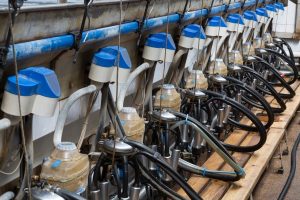As the demand for more automation increases, we are seeing it played out in more industries on a global scale. Precision dairy farming, which includes the use of automated milking and computerized systems to milk or feed dairy cattle, has been increasing steadily in the dairy industry in recent years. These systems represent significant advances in engineering, computing, and manufacturing.
Recently, four U.S. dairy farmers, two dairy trade journalists and several U.S. Dairy Export Council staffers visited the Vinamilk processing plant in Binh Duong province. Inside, pallet-carrying “automated guided vehicles,” commonly called robots, criss-crossed a massive warehouse with 17 floors of shelving. Without a single complaint, they tirelessly delivered electronically coded products exactly where a command control center told them to.
“We invest in high technology in order to protect the quality of the product,” Nguyen Quoc Khánh, Vinamilk’s executive director for R&D and production, told his U.S. visitors. “The more people who interrupt the system the more risk you have. Plus, the cost of labor is increasing year by year.”
Having modern dairy processing plants, equipped with robotics, is a selling point for dairy-exporting countries. For instance, Vietnam can point to the Vinamilk plant and say that its producers can compete with producers around the world in terms of production conditions. A senior executive from Vinamilk makes that claim in a recent article from VietNamNet Bridge concerning the likelihood that Vietnam will begin exporting dairy products to China.
Minnesota has the largest number of automated milking systems (a.k.a. robotic milking systems) of any state in the U.S. Great service, knowledgeable sales people and interested producers have helped drive the growth of this technology. Minnesota also has a very good number of automated calf feeding systems in operation.
Marcia Endres, along with Jim Salfer, conducted a field study on automated milking systems (AMS) in Minnesota and western Wisconsin. They started their project with a survey of approximately 30 producers in the region who had installed AMS. The goal was to learn what were the main reasons they decided to go in that direction, how the system was working for them, what were their feeding and management practices, and collect some initial data from the AMS.
As your company branches out into more robotic generated technology, having UKA design and manufacture your precision lenses will bring the highest level of satisfaction to your clients worldwide.
With an Automatic Milking System (AMS) producers can work smarter rather than harder. They might also enjoy a better quality of life with added flexibility in their schedule and activities – a clear advantage of robotic milking over conventional operations. A robot operator decides when to start, stop, continue and go home, making it possible to start later and finish earlier in the day. Producers also commented that cows are calmer and easier to handle. Milk production stayed the same or increased a little.
Automated calf feeders are another technology that is becoming more common in Minnesota. These systems offer some advantages related to labor costs, calf social interactions, and public preference. More observations still need to be done to establish cost analysis and productivity rates before we will see that on the larger scale.
Universe Kogaku designs and manufactures optical lenses for Automated Systems, security, high tech and electronic applications. We stock 1000’s of standard lens assemblies and can custom design a solution for scanners, CCTV, CCD/CMOS, medical imaging, surveillance systems, machine vision and night vision systems.